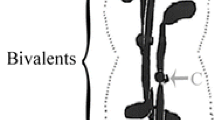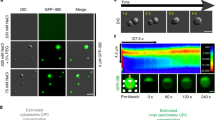Conclusions
The immunocytochemical “taxonomy” experiments cited above have identified a class of “chromosomal” antigens whose properties were not predicted by earlier models of mitosis. Our theory describing one possible explanation for the transfer of these antigens from the chromosomes to the spindle midzone at the metaphase: anaphase transition must now be subjected to further experimental tests. The phenotypes of cells microinjected with antibodies to passenger proteins should enable us to identify mitotic processes dependent on these proteins, as in the example of CHO1 antibody blocking mitotic progression (Nislow et al. 1990). In addition, the availability of cDNA clones and high titer antibodies may enable homologues of these components to be identified in organisms in which they can be subjected to genetic analysis.
For the time being, we suggest that current views of the relative roles of chromosomes and cytoskeletal components in mitosis may require revision. Our hypothesis takes the current model for the role of the kinetochores in organizing the bipolar mitotic spindle (Kirschner and Mitchison 1986) a step further. The process of assembling a functional spindle and positioning the cleavage furrow may entail a degree of functional cooperation between chromosomes and cytoskeletal components far beyond that envisioned before now.
Similar content being viewed by others
References
BernatRL, BorisyGG, RothfieldNF, EarnshawWC (1990) Injection of anticentromere antibodies in interphase disrupts events required for chromosome movement in mitosis. J Cell Biol 111: 1519–1533
BonifacinoJS, KlausnerRD, SandovalIV (1985) A widely distributed nuclear protein immunologically related to the microtubule-associated protein MAP1 is associated with the mitotic spindle. Proc Nat Acad Sci USA 82: 1146–1150
BrinkleyBR, ZinkowskiRP, MollonWL, DavisFM, PisegnaMA, PershouseM, RaoPN (1988) Movement and segregation of kinetochores experimentally detached from mammalian chromosomes. Nature 336: 251–254
BuckRC, TisdaleJM (1962) The fine structure of the mid-body of the rat erythroblast. J Cell Biol 13: 109–115
CandeWZ, McDonaldKL (1985) In vitro reactivation of anaphase spindle elongation using isolated diatom spindles. Nature 316: 168–170
Compton DA, Yen TJ, Cleveland DW (1991) Identification of novel centromere/kinetochore associated proteins using monoclonal antibodies generated against human mitotic chromosome scaffolds. J Cell Biol (in press)
CookeCA, HeckMMS, EarnshawWC (1987) The INCENP antigens: movement from the inner centromere to the midbody during mitosis. J Cell Biol 105: 2053–2067
Díaz-NidoJ, AvilaJ (1989) Characterization of proteins immunologically related to brain microtubule-associated protein MAP-1B in non-neural cells. J Cell Sci 92: 607–620
Earnshaw WC, Cooke CA (1991) Analysis of the distribution of the INCENPs during mitosis leads to the recognition of three distinct subdivisions of metaphase and early events in anaphase cleavage furrow formation. J Cell Sci (in press)
EarnshawWC, RattnerJB (1989) A map of the centromere (primary constriction) in vertebrate chromosomes at metaphase. In: VigB, ResnickM (eds) Aneuploidy: mechanisms of origin. Alan R Liss, New York, pp 33–42
GorbskyGJ, SammakPJ, BorisyGG (1987) Chromosomes move poleward in anaphase along stationary microtubules that coordinately disassemble from their kinetochore ends. J Cell Biol 104: 9–18
HartwellLH, WeinertTA (1989) Checkpoints: controls that ensure the order of cell cycle events. Science 246: 624–629
IzantJG, WeatherbeeA, McIntoshJR (1982) A microtubule-associated protein in the mitotic spindle and the interphase nucleus. Nature 295: 248–250
KingwellB, FritzlerMJ, DecoteauJ, RattnerJB (1987) Identification and characterization of a protein associated with the stembody using autoimmune sera from patients with systemic sclerosis. Cell Motil Cytoskel 8: 360–367
KirschnerM, MitchisonT (1986) Beyond self assembly: from microtubules to morphogenesis. Cell 45: 329–342
LydersenBK, PettijohnDE (1980) Human-specific nuclear protein that associates with the polar region of the mitotic apparatus: distribution in a human/hamster hybrid cell. Cell 22: 489–499
MaziaD (1961) Mitosis and the physiology of cell division. In: BrachetJ, MirskyAE (eds) The cell. Biochemistry, physiology, morphology. Academic, New York, pp 77–412
McIntoshJR, LandisSC (1971) The distribution of spindle microtubules during mitosis in cultured human cells. J Cell Biol 49: 468–497
McIntoshJR, McDonaldKL, EdwardsMK, RossBM (1979) Three-dimensional structure of the central mitotic spindle of Diatoma vulgare. J Cell Biol 83: 428–442
MullinsJM, BieseleJJ (1977) Terminal phase of cytokinesis in D-98S cells. J Cell Biol 73: 672–684
NewmeyerDD, Ohlsson-WilhelmBM (1985) Monoclonal antibody to a protein of the nucleus and mitotic spindle of mammalian cells. Chromosoma 92: 297–303
NicklasRB (1989) The motor for poleward chromosome movement in anaphase is in or near the kinetochore. J Cell Biol 109: 2245–2255
NislowC, SellittoC, KuriyamaR, McIntoshJR (1990) A monoclonal antibody to a mitotic microtubule-associated protein blocks mitotic progression. J Cell Biol 111: 511–522
PankovR, LemieuxM, HancockR (1990) An antigen located in the kinetochore region in metaphase and on polar microtubule ends in the midbody region in anaphase, characterized using a monoclonal antibody. Chromosoma 99: 95–101
PepperDA, KinHY, BernsMW (1984) Studies of a microtubule-associated protein using a monoclonal antibody elicited against mammalian mitotic spindles. J Cell Biol 99: 503–511
RappaportR (1986) Establishment of the mechanism of cytokinesis in animal cells. Int Rev Cytol 105: 245–281
RiederCL (1982) The formation, structure and composition of the mammalian kinetochore and kinetochore fiber. Int Rev Cytol 79: 1–58
RiederCL, AlexanderSP (1989) The attachment of chromosomes to the mitotic spindle and the production of aneuploidy in newt lung cells. In: ResnickMA, VigBK (eds) Mecanisms of chromosome distribution and aneuploidy. Alan R Liss, New York, pp 185–194
RoosUP (1973) Light and electron microscopy of rat kangaroo cells in mitosis. II. Kinetochore structure and function. Chromosoma 41: 195–220
SaxtonWM, McIntoshJR (1987) Interzone microtubule behavior in late anaphase and telophase spindles. J Cell Biol 105: 875–886
SellittoC, KuriyamaR (1988) Distribution of a matrix component of the midbody during the cell cycle of Chinese hamster ovary cells. J Cell Biol 106: 431–439
VanNessJ, PettijohnDE (1983) Specific attachment of nuclearmitotic apparatus protein to metaphase chromosomes and mitotic spindle poles: possible function in nuclear reassembly. J Mol Biol 171: 175–205
WordemanL, CandeWZ (1987) Reactivation of spindle elongation in vitro is correlated with the phosphorylation of a 205 kd spindle-associated protein. Cell 50: 535–543
WordemanL, MasudaH, CandeWZ (1989) Distribution of a thiophosphorylated spindle midzone antigen during spindle reactivation in vitro. J Cell Sci 93: 279–285
Yen TJ, Compton DA, Wise D, Zinkowski RP, Brinkley BR, Earnshaw WC, Cleveland DW (1991) CENP-E, a novel centromere associated protein required for progression from metaphase to anaphase. The EMBO J (in press)
ZirkleRE (1970) UV-microbeam irradiation of newt-cell cytoplasm: spindle destruction, false anaphase, and delay of true anaphase. Radiat Res 41: 516–537
Author information
Authors and Affiliations
Rights and permissions
About this article
Cite this article
Earnshaw, W.C., Bernat, R.L. Chromosomal passengers: Toward an integrated view of mitosis. Chromosoma 100, 139–146 (1991). https://doi.org/10.1007/BF00337241
Issue Date:
DOI: https://doi.org/10.1007/BF00337241




